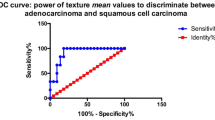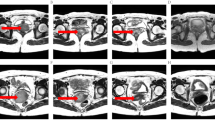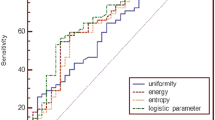Abstract
Objectives
Magnetic resonance imaging (MRI)-based texture analysis (MRTA) is a novel image analysis tool that offers objective information about the spatial arrangement of MRI signal intensity. We aimed to investigate the value of MRTA in predicting the postoperative clinical outcome of patients with uterine cervical cancer.
Methods
This retrospective study included 115 patients with surgically proven cervical cancer who underwent preoperative pelvic 3T-MRI, and MRTA was performed on T2-weighted images (T2), apparent diffusion coefficient (ADC) maps, and contrast-enhanced T1-weighted images (CE-T1). Filtration histogram-based texture analysis was used to generate six first-order statistical parameters [mean intensity, standard deviation (SD), mean of positive pixels (MPP), entropy, skewness, and kurtosis] at five spatial scaling factors (SSFs, 2–6 mm) as well as from unfiltered images. Cox proportional hazard models and time-dependent receiver operating characteristic analyses were used to evaluate the associations between parameters and recurrence-free survival (RFS).
Results
During a median follow-up of 36 months, tumor recurrence was found in 26 patients (22.6%). Multivariate analysis demonstrated that CE-T1 MPP and T2 kurtosis at SSF3–5, CE-T1 MPP at SSF6, and CE-T1 SD at unfiltered images were independent predictors of RFS (p < 0.05). Regarding the 2-year RFS for CE-T1 MPP and T2 kurtosis at SSF5, and CE-T1 MPP at SSF6, patients with > optimal cutoff values demonstrated significantly worse survival than those with ≤ optimal cutoff values (p < 0.05).
Conclusion
Preoperative MRTA may be useful for predicting postoperative outcome in patients with cervical cancer.
Graphic abstract




Similar content being viewed by others
Abbreviations
- ADC:
-
Apparent diffusion coefficient
- AUC:
-
Area under the curve
- CE-T1:
-
Contrast-enhanced fat-saturated T1-weighted
- CI:
-
Confidence interval
- DWI:
-
Diffusion-weighted imaging
- FIGO:
-
International Federation of Gynecology and Obstetrics
- FOV:
-
Field of view
- HR:
-
Hazard ratio
- MPP:
-
Mean of positive pixels
- MRI:
-
Magnetic resonance imaging
- MRTA:
-
MRI-based texture analysis
- NSA:
-
Number of signals acquired
- RFS:
-
Recurrence-free survival
- ROC:
-
Receiver operating characteristics
- ROI:
-
Region-of-interest
- SCC:
-
Squamous cell carcinoma
- SD:
-
Standard deviation
- SENSE:
-
Sensitivity encoding
- SSF:
-
Spatial scaling factor
- TA:
-
Texture analysis
- TE:
-
Echo time
- TR:
-
Repetition time
References
Torre LA, Siegel RL, Ward EM, Jemal A (2016) Global Cancer Incidence and Mortality Rates and Trends—An Update. Cancer Epidemiol Biomarkers Prev 25:16–27. https://doi.org/10.1158/1055-9965.EPI-15-0578
Sala E, Rockall AG, Freeman SJ, Mitchell DG, Reinhold C (2013) The added role of MR imaging in treatment stratification of patients with gynecologic malignancies: what the radiologist needs to know. Radiology 266:717–740. https://doi.org/10.1148/radiol.12120315
Wakefield JC, Downey K, Kyriazi S, deSouza NM (2013) New MR techniques in gynecologic cancer. Am J Roentgenol 200:249–260. https://doi.org/10.2214/AJR.12.8932
Dagogo-Jack I, Shaw AT (2018) Tumour heterogeneity and resistance to cancer therapies. Nat Rev Clin Oncol 15:81–94. https://doi.org/10.1038/nrclinonc.2017.166
Davnall F, Yip CS, Ljungqvist G, Selmi M, Ng F, Sanghera B, Ganeshan B, Miles KA, Cook GJ, Goh V (2012) Assessment of tumor heterogeneity: an emerging imaging tool for clinical practice? Insights Imaging 3:573–589. https://doi.org/10.1007/s13244-012-0196-6
Chen SW, Shen WC, Hsieh TC, Liang JA, Hung YC, Yeh LS, Chang WC, Lin WC, Yen KY, Kao CH (2018) Textural features of cervical cancers on FDG-PET/CT associate with survival and local relapse in patients treated with definitive chemoradiotherapy. Sci Rep 8:11859. https://doi.org/10.1038/s41598-018-30336-6
Meng J, Liu S, Zhu L, Zhu L, Wang H, Xie L, Guan Y, He J, Yang X, Zhou Z (2018) Texture Analysis as Imaging Biomarker for recurrence in advanced cervical cancer treated with CCRT. Sci Rep 8:11399. https://doi.org/10.1038/s41598-018-29838-0
Yoon A, Park JJ, Park BK, Lee YY, Paik ES, Choi CH, Kim TJ, Kim CK, Lee JW, Bae DS, Kim BG (2016) Long-term Outcomes of MRI Stage IIB Cervical Cancer. Int J Gynecol Cancer 26:1252–1257. https://doi.org/10.1097/IGC.0000000000000762
Park JY, Lee JW, Park BK, Lee YY, Choi CH, Kim TJ, Bae DS, Kim BG, Park JJ, Park SY, Kim CK (2014) Postoperative outcomes of MR-invisible stage IB1 cervical cancer. Am J Obstet Gynecol 211:168 e161–167. https://doi.org/10.1016/j.ajog.2014.02.032
Heo SH, Shin SS, Kim JW, Lim HS, Jeong YY, Kang WD, Kim SM, Kang HK (2013) Pre-treatment diffusion-weighted MR imaging for predicting tumor recurrence in uterine cervical cancer treated with concurrent chemoradiation: value of histogram analysis of apparent diffusion coefficients. Korean J Radiol 14:616–625. https://doi.org/10.3348/kjr.2013.14.4.616
Lund KV, Simonsen TG, Kristensen GB, Rofstad EK (2017) Pretreatment late-phase DCE-MRI predicts outcome in locally advanced cervix cancer. Acta Oncol 56:675–681. https://doi.org/10.1080/0284186X.2017.1294762
Fang J, Zhang B, Wang S, Jin Y, Wang F, Ding Y, Chen Q, Chen L, Li Y, Li M, Chen Z, Liu L, Liu Z, Tian J, Zhang S (2020) Association of MRI-derived radiomic biomarker with disease-free survival in patients with early-stage cervical cancer. Theranostics 10:2284–2292. https://doi.org/10.7150/thno.37429
Pecorelli S (2009) Revised FIGO staging for carcinoma of the vulva, cervix, and endometrium. Int J Gynaecol Obstet 105:103–104
Ganeshan B, Miles KA (2013) Quantifying tumour heterogeneity with CT. Cancer Imaging 13:140–149. https://doi.org/10.1102/1470-7330.2013.0015
Wang M, Perucho JAU, Tse KY, Chu MMY, Ip P, Lee EYP (2020) MRI texture features differentiate clinicopathological characteristics of cervical carcinoma. Eur Radiol 30:5384–5391. https://doi.org/10.1007/s00330-020-06913-7
Ho KC, Fang YH, Chung HW, Yen TC, Ho TY, Chou HH, Hong JH, Huang YT, Wang CC, Lai CH (2016) A preliminary investigation into textural features of intratumoral metabolic heterogeneity in (18)F-FDG PET for overall survival prognosis in patients with bulky cervical cancer treated with definitive concurrent chemoradiotherapy. Am J Nucl Med Mol Imaging 6:166–175
Prescott JW, Zhang D, Wang JZ, Mayr NA, Yuh WT, Saltz J, Gurcan M (2010) Temporal analysis of tumor heterogeneity and volume for cervical cancer treatment outcome prediction: preliminary evaluation. J Digit Imaging 23:342–357. https://doi.org/10.1007/s10278-009-9179-7
Lee J, Kim CK, Park SY (2020) Histogram analysis of apparent diffusion coefficients for predicting pelvic lymph node metastasis in patients with uterine cervical cancer. MAGMA 33:283–292. https://doi.org/10.1007/s10334-019-00777-9
Wormald BW, Doran SJ, Ind TE, D'Arcy J, Petts J, deSouza NM (2020) Radiomic features of cervical cancer on T2-and diffusion-weighted MRI: Prognostic value in low-volume tumors suitable for trachelectomy. Gynecol Oncol 156:107–114. https://doi.org/10.1016/j.ygyno.2019.10.010
Miles KA, Ganeshan B, Hayball MP (2013) CT texture analysis using the filtration-histogram method: what do the measurements mean? Cancer Imaging 13:400–406. https://doi.org/10.1102/1470-7330.2013.9045
Ciolina M, Vinci V, Villani L, Gigli S, Saldari M, Panici PB, Perniola G, Laghi A, Catalano C, Manganaro L (2019) Texture analysis versus conventional MRI prognostic factors in predicting tumor response to neoadjuvant chemotherapy in patients with locally advanced cancer of the uterine cervix. Radiol Med 124:955–964. https://doi.org/10.1007/s11547-019-01055-3
Ytre-Hauge S, Dybvik JA, Lundervold A, Salvesen OO, Krakstad C, Fasmer KE, Werner HM, Ganeshan B, Hoivik E, Bjorge L, Trovik J, Haldorsen IS (2018) Preoperative tumor texture analysis on MRI predicts high-risk disease and reduced survival in endometrial cancer. J Magn Reson Imaging 48:1637–1647. https://doi.org/10.1002/jmri.26184
Park JJ, Kim CK, Park SY, Park BK, Kim B (2014) Value of diffusion-weighted imaging in predicting parametrial invasion in stage IA2–IIA cervical cancer. Eur Radiol 24:1081–1088. https://doi.org/10.1007/s00330-014-3109-x
Kim HS, Kim CK, Park BK, Huh SJ, Kim B (2013) Evaluation of therapeutic response to concurrent chemoradiotherapy in patients with cervical cancer using diffusion-weighted MR imaging. J Magn Reson Imaging 37:187–193. https://doi.org/10.1002/jmri.23804
Xue H, Ren C, Yang J, Sun Z, Li S, Jin Z, Shen K, Zhou W (2014) Histogram analysis of apparent diffusion coefficient for the assessment of local aggressiveness of cervical cancer. Arch Gynecol Obstet 290:341–348. https://doi.org/10.1007/s00404-014-3221-9
Song M, Lin J, Song F, Wu D, Qian Z (2020) The value of MR-based radiomics in identifying residual disease in patients with carcinoma in situ after cervical conization. Sci Rep 10:19890. https://doi.org/10.1038/s41598-020-76853-1
Gourtsoyianni S, Doumou G, Prezzi D, Taylor B, Stirling JJ, Taylor NJ, Siddique M, Cook GJR, Glynne-Jones R, Goh V (2017) Primary Rectal Cancer: Repeatability of Global and Local-Regional MR Imaging Texture Features. Radiology 284:552–561. https://doi.org/10.1148/radiol.2017161375
Acknowledgements
We thank Sook Young Woo, PhD of Statistics and Data Center, Samsung Medical Center, for help with statistical assistance and thank Editage (www.editage.co.kr) for English language editing.
Author information
Authors and Affiliations
Corresponding author
Ethics declarations
Conflict of interest
The authors report no conflict of interest concerning the materials or methods used in this study or the findings specified in this paper.
Additional information
Publisher's Note
Springer Nature remains neutral with regard to jurisdictional claims in published maps and institutional affiliations.
Supplementary Information
Below is the link to the electronic supplementary material.
Rights and permissions
About this article
Cite this article
Kim, K.E., Kim, C.K. Magnetic resonance imaging-based texture analysis for the prediction of postoperative clinical outcome in uterine cervical cancer. Abdom Radiol 47, 352–361 (2022). https://doi.org/10.1007/s00261-021-03288-1
Received:
Revised:
Accepted:
Published:
Issue Date:
DOI: https://doi.org/10.1007/s00261-021-03288-1




